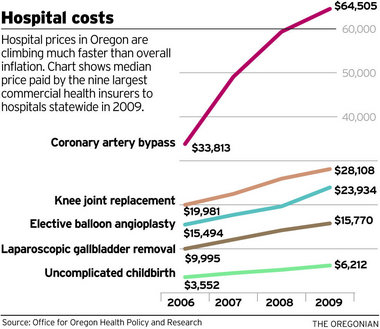A reader tipped me off to this story out of Oregon,
When Oregon began disclosing details of hospital billing three years ago, officials hoped to spur competition that would hold back costs and reduce the huge variations in rates from hospital to hospital. The latest data from 2009 suggest that little has changed. Hospitals with the most clout command payments two to three times higher than the lowest-priced hospitals. And hospital costs overall continue to soar. […]
The payment data suggest that lack of competition explains much of the difference in prices. Cities with one hospital tend to have higher prices. St. Charles Medical Center in Bend, for example, stands out as one of the costliest in the state. In Portland, where numerous hospitals compete, payments are consistently lower than the state average. Among Portland hospitals, multihospital systems such as Providence tend to command higher payments than smaller competitors such as Adventist Medical Center or Tuality Health Care.
While descriptive and only from one state, this basic story is consistent with numerous others (from California and Massachusetts) and more rigorous research I’ve blogged about considerably. Hospital market power increases prices. Know what helps offset that effect? Insurer market power.
A few other things might help too. One is pushing some of the cost risk to the entities involved in the transaction. Some of it–in particular that for elective or unnecessary or ineffective procedures–should be borne by individuals. That only goes so far. Even a “high” deductible of a few thousand dollars doesn’t buy much. Burn through that and what’s left to control costs?
Thus, a lot of the cost risk should be borne by hospitals and physicians. They’re calling the shots. That’s why we see them and don’t diagnose ourselves and prescribe our own treatment (usually).
There are many ways to help control health costs. Currently, our system employs very few of them.



